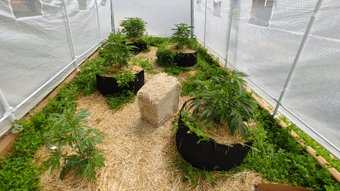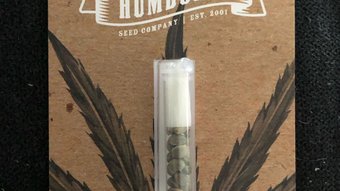Foundation Courses. Ch. 1: UNDERSTANDING SOIL. Lecture 2: UNDERSTANDING THE COMPONENTS OF SOIL
About :
Chapter 1 Lecture 2 Notes baby!
These are the notes that I took from the Chapter 1, lecture two part of the Foundation courses from Elaine Ingram's Soil Food Web Online School. These notes are very thorough but you really do need the actual lecture and access to the forums to be able to complete these end of lecture quizzes. I have to watch these lectures over and over again and even while taking these quizzes. There is a, as they call it in the forums, analytical way the questions are presented.
Here are some youtube videos I found that go over some material covered in todays lecture I studied and took a quiz on.*
Chapter 1: UNDERSTANDING SOIL
Lecture 2: UNDERSTANDING THE COMPONENTS OF SOIL
Why be concerned with soil life?
Healthy Plants
Do not need toxic chemicals to grow
- pesticides, herbicides, insecticides chemical fertilizers
- anything that ends with an icides is meant to kill
Have proper balance of nutrients
- causes of imbalance
- loss of biological life
- tillage
- added icides
- Can tell by taste and hunger satisfaction
- Trust taste buds when eating food. If no taste or off taste then consider avoiding
Flavor is dependent on nutrient balance in plant
Where do plants get their nutrients?
- All but two nutrients come from the soil
- Plants only need 2 nutrients from above ground -- Carbon Dioxide and Energy from the sun.
Plants take in carbon dioxide from the atmosphere and separate the carbon atom from the double-bonded, two oxygen atoms. The plant then keeps the carbon atom to use in forming all of the carbon compounds present in the plant tissue. The plant releases the oxygen atoms back into the atmosphere as a waste compound of this process.
The energy fueling this process comes from sunlight. The plant uses this energy to pull apart the carbon atoms from the oxygen atoms. This process is called photosynthesis.
The Soil Food Web

1st level – Photo Synthesizers
2nd level – Decomposers, Mutualist, Pathogens, Parasites, and root-feeders
3rd level – Shredders, Predators, Graziers
4th level – Higher level Predators
5th level – Higher level Predators
Exudates
- Any thing that can be produced and released by an organism
- Mostly sugar
Root exudates are in the form of carbohydrates, including sugars, and proteins. Amazingly, their presence wakes up, attracts, and grows specific beneficial bacteria and fungi living in the soil that subsist on these exudates and the cellular material sloughed off as the plant’s root tips grow.
The specific beneficial bacteria and fungi living in the soil then begin to extract nutrients from the Soil/ Mineral components and Organic matter. Protozoa and Nematodes then consume the Bacteria and Fungi, their poop then becomes nutrients that are released in soluble plant available forms to the root zone.
- All organisms in the soil are critical
Total Nutrient Pool

3- Soil Nutrient pools
1- Total
2- Exchangeable
3- Soluble
Testing total pools for nutrients requires grinding soil to a dust, adding concentrated nitric acid to soil, combusting and then adding chemicals.
Testing has different extracting chemicals/ oxidizing agents involved for each nutrient pool.
Total (soil) pool - Not normally reported
- All nutrients are present in massive numbers in this pool.
10% HCL, H2HN03
Plant tissue tests use the same test method. Best way to measure what your plant is able to uptake from soil.
Clays have more + and - exchange sites but other minerals have less exchange sites.
Mistake to say clays only have + and - exchange sites.
Exchangeable Pool - Ions bound on surfaces of organic matter, sand, silt, clay and organisms.
650 different extracting agents. Each one gives you a different #.
Melich 3
- Strong extraction agent (acid). Most of exchangeable pool and some of total. Hard to interpret.
Bray 2
- Not as strong of extraction agent, Average value
Amm Cl/ BaCl
- Much less ions are pulled off.
Soluble Pool - disolved in water. Plant available nutrients.
1000 different extracting agents for soluble pool. Each one gives you a different #.
Overall there trouble with chemical agent extractions with providing inconsistent data.
All soluble nutrients(inorganic fertilizers) are salts. Takes water away from plant. + and - parts of the soluble inorganic nutrients will become in solution. Easily washed out of soil with rains or irrigation. Kills beneficial organisms.
The Water molecule has a polar positive and negative charge. Salt molecule (Chemical fertilizers) has a ionic positive and negative charge.
Water molecules will bind with the positive charged sodium and also the negatively charged chloride atoms.
Ionic bond is broken with sodium chloride.
Lime is a fungicide and a salt. Will most likely kill more good fungi than bad.
Agronomist Optimum Element/Nutrient Levels

Old Growth forests are able to thrive despite lower than recommended PPM of Nutrients in soil due to a healthy Soil Food Web (bacteria, fungi, micro-organisms, insects, etc). Nutrients are replenished every second of every day.
Typical conventional pastures/growing areas have their soluble(salt based) nutrients washed away with irrigation or rains. So agronomists recommend to use high amounts of soluble nutrients.
Soil Organic Matter
Where does it come from?
- Dead plant material
- Plant exudates
- Bacteria and fungal decomposition
- Waste material from organisms
Simple to Complex Organic Matter
Bacterial
Exudates or photosynthetic organisims makes sugars. When a nitrate molecule is pulled into the plant or micro-organism and puts a NH2 group onto the carbon can it change your sugar into an amino acid
Sugar - Unbranched (simple) Carbon Chains (favorite food of bacteria)
Amino Acids - Unbranched sugars with N (NH2) (nitrate or ammonium)
Bacterial and Fungal
Protein - 1-10,000 amino acids, branched and other nutrients (every protein group has a NH2 group and also all types of nutrients)
Lipo-polysaccharides - Branched PO4 (multiple sets of sugars, makes membranes and cell walls)
Hormones - Long protein chains, cyclical (Carbons form a circle instead of chain)
Fungal
Fungi makes enzymes that can penetrate complex structures
Ulmic acids - Highly branched (complex with carbon rings), rings (high in molecular weight)
Fulvic acids - More highly branched (complex with carbon rings); tan color
Humic acids - Extremely branched (complex with carbon rings), complex brown color ( 100+ fulvic acids linked together)
Condensation - Release of waste by bacteria and fungi, as they grow, they start linking those wastes together.
Simplest sugars
- Two-three Carbons. Bacterial foods
Carbon to Nitrogen Ratios C:N
The ratio of the number carbon atoms relative to the number of Nitrogen atoms gives clues to several important factors in growing plants.
Is the balance of C and N within the plant tissue correct?
Is the plant stressed? If C:N ratio is off then yes it will be. 30:1 C:N ratio is ideal.
Is the organic matter better fungal food or bacterial food?
How rapidly will the organic matter decompose, if the correct bacterial and fungal species are present? Are predators present to release (nutrient cycling) soluble nutrients?
The plant itself will strongly influence C:N ratios by the exudates it releases and the root cells it sloughs.
Food Sources for Soil Organisms
Bacterial Foods
- Molasses
- Sugars
- Simple Amino Acids
- Simple Proteins (not bra
- Simple Carbohydrates
(Simple means Not branched or not bound to anything else)
Fungal Foods
- Humic Acids
- Complex Proteins
- Oatmeal
- Bran
- Fish Hydrolysate
- Wide C:N ratio Foods ie 500:5
(Complex)
Micro-organisms: Appearance and Function
Morphology - Deciding Characteristics. What do they look like?
Function - What each groups does.
Active - Actively metabolizing organisms (respiring, making enzymes, producing wastes) that meet criteria for ID of that group. Subset of total organisms present.
Total - All the organisms that meet the criteria, includes: Extremely to Not very active, Moribund, Dead but ID can still be made. No dormant stages included. Total organisms are looked at when analyzing organisms. Time course studies are used if we need to know what the total biomass/# organisms is growing or being used. Stains can be used. We look at total organisms often because its easier to look at and cheaper.
The Amount of Species or Individual organisms
Why?
A high number/ diversity of species means all the functions of that group will be performed; a low number means the plant will suffer. Lots of individual species active is needed to do their jobs. These organisms need to be aerobic.
Numbers vs Biomass
Largest organisms on the planet are fungi and bacteria are the smallest organisms.
We need to know Biomass, not numbers.
largest organism on planet is 20 miles in diameter and 25 feet into soil. Fungus in the Olympic peninsula. Fungus will always be larger than bacteria always.
Nematodes and protozoa we will count numbers due to size differential with each species of such.
400x magnification is needed to look at soil biology
Ciliates eat bacteria, can see bacteria inside body. tiny hairs on outside of body.
Bacteria will look like rods and round circles. They will make glue and stick together acids into an aggregate structure. Form massive wall around the plant roots.
Fungi can be seen with naked eye. 100's of strands of fungal hypha make up the visible fungus.
Nematodes can be identified by mouth. if they are parasitic or beneficial.
Bacteria and fungi form a massive wall around roots because plants feed them.
Protozoa and nematodes are attracted to the large number of their prey (bacteria and fungi) release nutrients
Because nutrients are so much higher in bacteria and fungi in their predators, excess nutrients are released, but in plant available forms
Examples of good soil. Structure and color.
Excellent Soil
- 70% Cocoa Chocolate color
- Smells like Old Growth Forest
- Airways and passageways are visible
Subpar Soil
- Under 70% Cocoa Chocolate Color
- Odors that do not smell like an Old Growth Forest
- Few Airways and passageways
Terrible soil (dirt)
- Very Light Color
- Foul Odors
- No Airways or Passageways Visible. Compacted. Dry.
Quiz!

Tags :
Their limit for today is $0!
More Videos
@arcange: 1.7281
@c0ff33a: 1.1167
@neoxiancityvb: 0.8576
@ecotrain: 0.6902
@jerrybanfield: 0.2175
@laruche: 0.2116
@tomiscurious: 0.1815
@canna-curate: 0.1795






























Comments:
Reply:
To comment on this video please connect a HIVE account to your profile: Connect HIVE Account